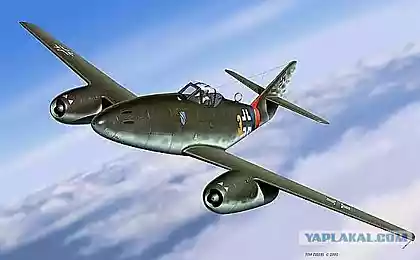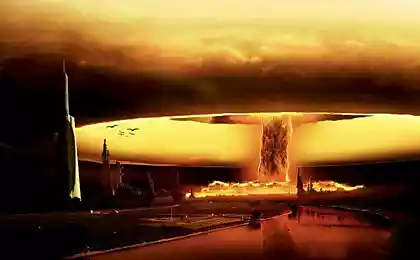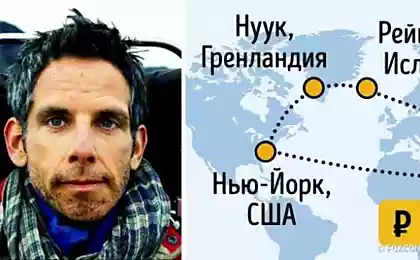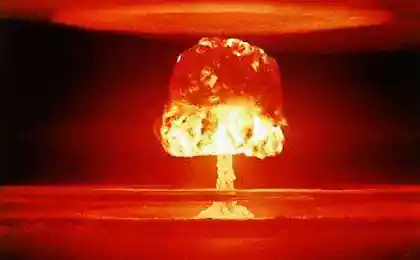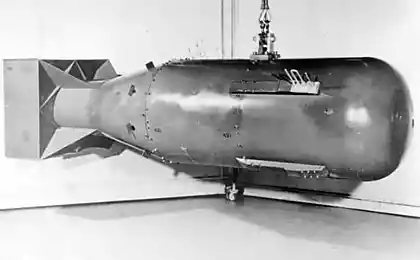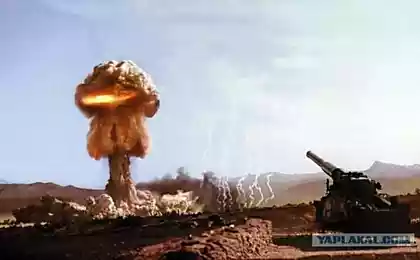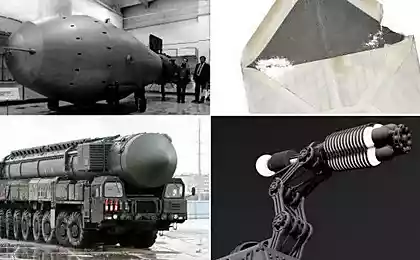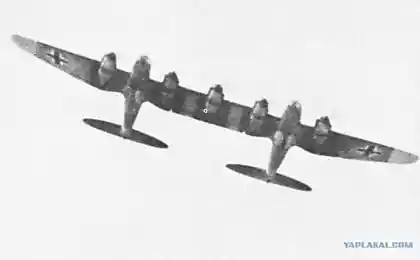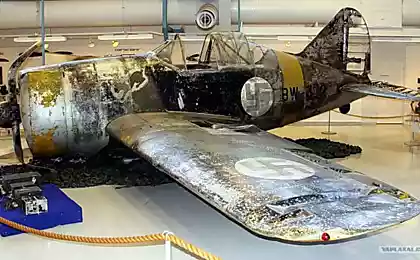2719
Atomic plane M-60M
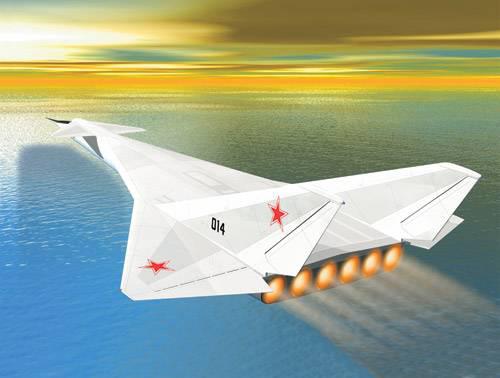
Second, the task of creating a jet bomber flight distance required with conventional power plant in the 1950s. seemed insurmountable complicated. Especially, supersonic, which was dictated by the need for the rapid development of air defense. Flights first Soviet supersonic strategic carrier M-50 have shown that with a load of 3-5 m even at two in-flight refueling of its range can barely reach 15,000 km. But how refuel at supersonic speed, and besides, over enemy territory, nobody could answer. The need for refueling significantly reduced the probability of a combat mission, and in addition, such a flight required a huge amount of fuel - a total of more than 500 tons of filled and to refuel aircraft. That is, only one flight regiment bombers could spend more than 10 thousand. Tonnes of kerosene! Even the simple accumulation of fuel reserves grew into a huge problem, not to mention the safe storage and protection from possible air strikes.
At the same time, there existed a powerful scientific and industrial base for solving various problems of nuclear energy. Its beginning she took from the number 2 Laboratory of the Academy of Sciences of the USSR, organized under the leadership of Kurchatov in the midst of World War II - in April 1943 At first the main task of nuclear scientists was to create a uranium bomb, but then began actively seeking other opportunities Use of a new kind of energy. In March 1947 - a year later than in the US - in the Soviet Union for the first time at the national level (at the meeting of the Scientific and Technical Council of the First Chief Directorate of the Council of Ministers) raised the issue of the use of the heat of nuclear reactions in the power plant. The Council decided to start systematic research in this area in order to develop the scientific foundations of using nuclear fission power generation and propulsion of ships, submarines and aircraft.
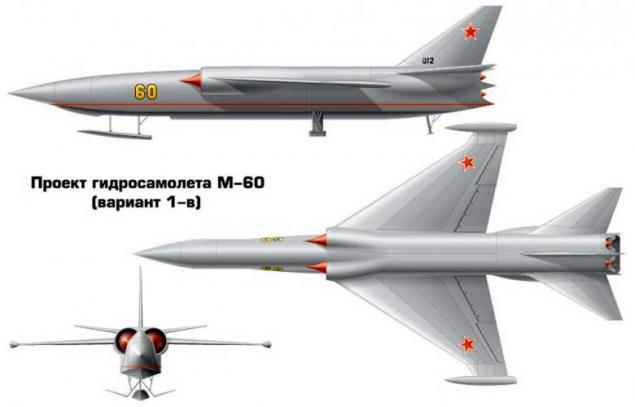
Became the scientific leader of the future academician A.P.Aleksandrov. We considered several options for nuclear power plants Aircraft: open and closed loop on the basis of ramjet, turbojet and turboprop engines. Developed various types of reactors: air and liquid metal with intermediate cooling, thermal and fast neutrons, etc. Investigated suitable for use in aviation coolants and ways to protect the crew and onboard equipment from the effects of radiation. In June 1952 Kurchatov Alexandrov reported: "... Our knowledge in the field of nuclear reactors allow you to put the establishment in the coming years on the engines of atomic energy used for heavy aircraft ...».
However, the idea to make its way, it took another three years. During this time, managed to climb into the sky first M-4 and TU-95, began working in Moscow the world's first nuclear power plant, began construction of the first Soviet nuclear submarine. Our agents in the United States began to transmit information on the extensive work carried out there on the creation of the atomic bomber. These data were perceived as a confirmation of the prospect of a new kind of energy for aviation. Finally, August 12, 1955 the Resolution of the Council of Ministers № 1561-868, which forced a number of aviation industry to begin work on nuclear issues. In particular, the Tupolev OKB-156, DB-23 and DB-VM Myasischev 301 Lavochkin had to do the design and construction of aircraft with nuclear power plants, and the OKB-276 ND Kuznetsova and OKB-165 A.M.Lyulki - development of SU.
The simplest technically task was given to the OKB-301, led by Lavochkin - develop an experimental cruise missile "375" nuclear ramjet engine OKB-670 M.M.Bondaryuka. Place conventional combustion chamber in the engine held reactor operating in an open cycle - air flows right through the core. The basis for the airframe missiles were taken to develop an intercontinental cruise missile "350" with a conventional ramjet. Despite the relative simplicity of the theme of "375" has not received any significant development and Lavochkin death in June 1960 and put an end to all these works.
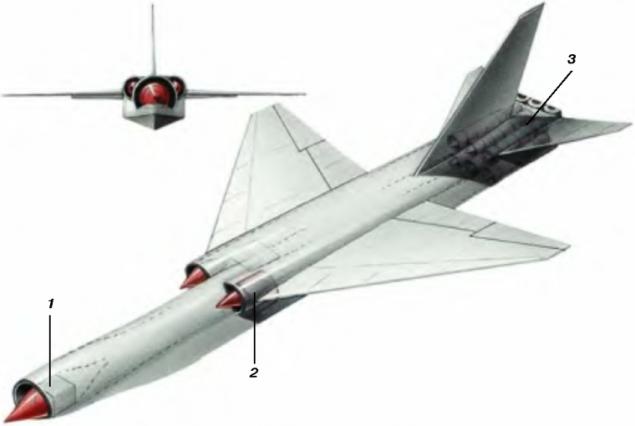
Myasishcheva team, then occupied by the creation of the M-50, were instructed to perform a preliminary draft of a supersonic bomber "with special engines A.M.Lyulka chief designer." In EDO theme was the index "60", the lead designer on her appointed Yu.N.Trufanova. As in the most general terms the solution of simple equipment seen in the M-50 engines on nuclear energy, and working in an open cycle (for simplicity), it was thought that the M-60 will be the first in the USSR atomic plane. However, by the middle of 1956 it became clear that so simple a task can not be solved. It turned out that the car with the new SU has a number of specific features, which aircraft designers had never before encountered. The novelty of the problems was so great that no one in the bureau, and in all the mighty Soviet aircraft industry even had no idea how to approach to their solution.
The first problem was to protect people from radiation. What should it be? How much should weigh? How to ensure the proper functioning of the crew, a prisoner in an impenetrable thick-walled capsule, including review with jobs and emergency escape? The second problem - a sharp deterioration of the usual construction materials caused by powerful streams of radiation and heat from the reactor. Hence - the need to create new materials. The third - the need to develop a completely new technology and operation of nuclear aircraft construction respective airbases with numerous underground structures. After all, it was found that after stopping the engine open cycle no one to him will not be able to come for 2-3 months! So, there is need for a remote ground handling of aircraft and engines. And, of course, security concerns - in the broadest sense, especially in the case of such an aircraft accident.
Awareness of these and many other problems not a stone was left from the original idea to use the M-50 airframe. The designers focused on finding new layout in which these problems seem to be crucial. In this case, the main criterion for selecting the location of the nuclear power plant on the plane was considered the maximum of its removal from the crew. Accordingly, the draft design was designed M-60, in which four atomic TRD located in the aft fuselage pairs in "two stories", forming a single nuclear compartment. The plane had a scheme with a thin cantilever sredneplana tapered wing and horizontal tail in the same located on the top of the keel. Missile and bomb armament was planned to place on the inside of the suspension. The length of the aircraft had to be around 66 m, take-off weight - to exceed 250 tonnes and the cruising speed - 3000 km / h at an altitude of 18,000-20,000 m.
The crew was to be located in a remote capsule with a powerful multi-layer protection of special materials. Radioactivity air excluded the possibility of using it for cabin pressurization and breathing. For this purpose we had to use an oxygen-nitrogen mixture obtained by special gasifier gases by vaporizing liquid on board. The lack of visual review was compensated periscopes, television and radar screens, as well as the installation of a fully automatic control system of the aircraft. Last was to provide all phases of flight, including takeoff and landing, the output of the target, etc. This logically leads to the idea of unmanned strategic bomber. However, the BBC insisted on manned version as more reliable and flexible to use.
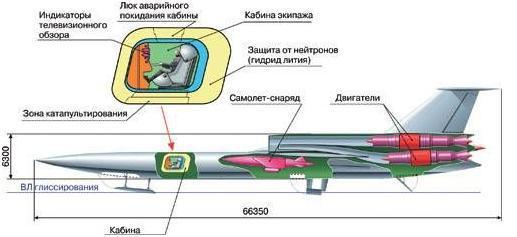
Nuclear turbojet engines for the M-60 had to develop a takeoff thrust of the order of 22500 kg. EDO A.M.Lyulki develop them in two versions: "coaxial" schemes, in which the annular reactor was placed behind the conventional combustion chamber, and through it passed the turbocharger shaft; and schemes "rocker" - with a curved part of the flow and elimination of the reactor outside the shaft. Myasischevtsy tried to apply and that, and another type of engine, finding in each of them are both advantages and disadvantages. But the main conclusion, which was contained in the conclusion to the preliminary draft of the M-60, was: "... along with the great difficulty of creating an engine, equipment and airframe arise entirely new problems of ground operation and protection of the crew, the population and area in case of an emergency landing. These problems have not been resolved .... At the same time, it is the ability to solve these problems is determined by the feasibility of establishing a manned aircraft with a nuclear engine. " Truly prophetic words!
In order to transfer the solution of these problems in a practical plane, V.M.Myasischev began drafting a flying laboratory based on the M-50, in which one atomic engine would be located in the forward fuselage. And in order to radically improve the survivability of nuclear aircraft bases in case of war were asked to opt out of the use of concrete runway, and the atomic bomber turned into a supersonic (!) Flying boat M-60M. This project was developed in parallel overland variant and kept him considerable continuity. Of course, this wing and the air motors were raised above the water as possible. Landing devices include nasal gidrolyzhu, ventral retractable hydrofoils and rotary floats lateral stability at the wing tips.
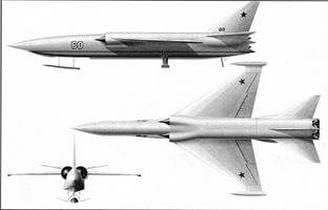
Problems before designers were difficult, but the work went on, and gave the impression that all difficulties can be overcome in time for substantially less than the increase range of conventional aircraft. In 1958 V.M.Myasischev on the instructions of the Presidium of the CPSU Central Committee issued a report "Status and Potential Strategic Air Command," which clearly stated: "... In view of the considerable criticism of the draft M-52K and 56K-M [bombers on regular fuel - Ed.] Department of Defense through the failure range of such systems, it seems useful to concentrate all work on strategic bombers on creating a supersonic bomber system with atomic engines, providing the necessary flight range for reconnaissance and bombing suspended for a point-aircraft shells and rockets on moving and stationary targets ».
Myasischev meant, first of all, the new draft of the strategic bomber-missile with a nuclear power plant closed circuit that designed OKB ND Kuznetsov. This machine he expected to create up to 7 years. In 1959, she was chosen for aerodynamic configuration "duck" with a delta wing and canard large sweep. Six nuclear turbojets supposed to put in the tail section of the plane and combined into one or two packages. The reactor was placed in the fuselage. As the coolant liquid metal to be used: sodium or lithium. The engines had the opportunity to work and kerosene. Closed cycle of the SU allows you to make the cockpit ventilated atmospheric air and much lower weight protection. At takeoff weight of about 170 tons of weight engines with heat exchangers was assumed to be 30 tons, the protection of the reactor and the cockpit 38 tons, 25 tons of payload. The length of the aircraft receives about 46 m in span of about 27 m.
The first flight of the M-30 was planned for 1966, but the OKB-23 Myasishcheva not had time to even begin to detailed design. Resolution of the Government of OKB-23 Myasishcheva attracted to the development of a multi-stage ballistic missile design bureau-52 Chelomei and autumn of 1960 eliminated as an independent organization, making this branch №1 EDO and fully adapted to the missile and space theme. Thus, the groundwork for the DB-23 atomic planes was not realized in actual construction.
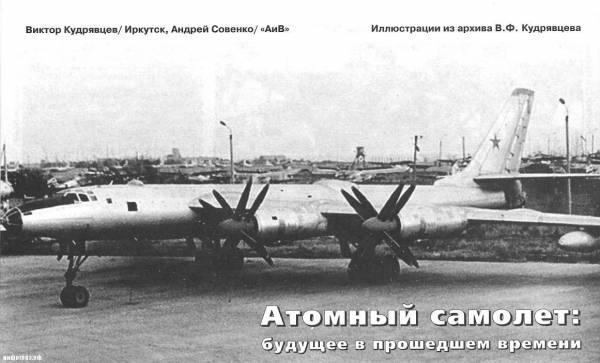
Unlike V. Myasishev team tries to create a supersonic strategic aircraft before OKB Tupolev-156 was originally set a more realistic goal - to develop a subsonic bomber. In practice, this problem was exactly the same as standing in front of American designers - to equip the reactor already existing machine, in this case, the Tu-95. But did not have time even to comprehend Tupolev forthcoming work in December 1955 to channel Soviet intelligence began to receive notice of the test flights in the US B-36 reactor on board. Recalls N.N.Ponomarev-steppe, now an academician, and in those years, a young employee of the Kurchatov Institute: "... Once Merkin [one of the closest colleagues Kurchatov - auth.] Kurchatov called and said that he has evidence that in America, the plane flew to the reactor. He now goes to the theater, but by the end of the play he should have information about the possibility of such a project. Merkin collected us. It was a "brainstorming". We came to the conclusion that such a plane is. He is on board the reactor, but it flies on normal fuels. And in the air is the study of the dispersion of the radiation flux, which we so worried. Without such studies to link protection at the atomic plane is impossible. Merkin went to the theater, where he told Kurchatov about our findings. After that, Kurchatov proposed to conduct similar experiments Tupolev ... ».
March 28, 1956 issued a decree of the USSR, according to which Tupolev began designing a flying atomic Laboratory (LAL) on the basis of serial Tu-95. Direct participants in these studies and V.M.Vul D.A.Antonov talk about that time: "... First of all, in accordance with its usual procedure - first all clear - Tupolev organized a series of lectures, seminars, in which leading nuclear scientists of the country A.P.Aleksandrov, A.I.Leypunsky, N.N.Ponomarev-Steppe, V.I.Merkin et al. told us about the physical basis of atomic processes, device reactors, with the protection requirements to content , control system, etc. Very soon these seminars began a lively discussion: how to combine technique with atomic carried aboard aircraft requirements and limitations. Here is one example of such discussions: the volume of the reactor plant nuclear scientists originally outlined to us, as the volume of a small house. But the builders were able to strongly OKB "compress" its dimensions, especially protective structures, while meeting all stated requirements in terms of protection for LAL. At one of the seminars Tupolev noted that "... the houses on the aircraft do not carry" and showed our layout. Nuclear scientists were surprised - they first met with such a compact solution. After careful analysis, it was jointly adopted for LAL on the Tu-95 ".
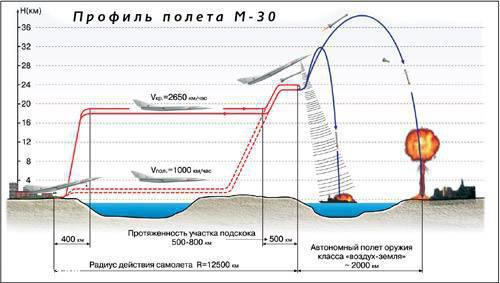
Atomic TRD scheme "Rocker»
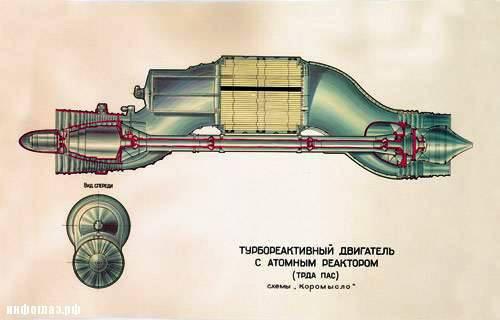
Atomic TRD "coaxial" schemes
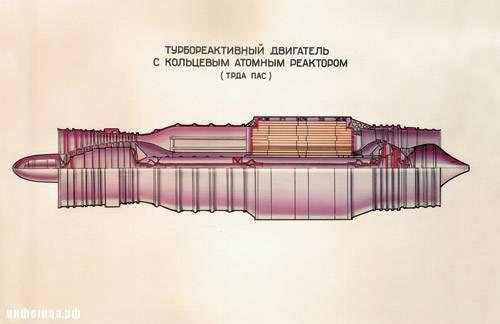
Ground test bench reactor
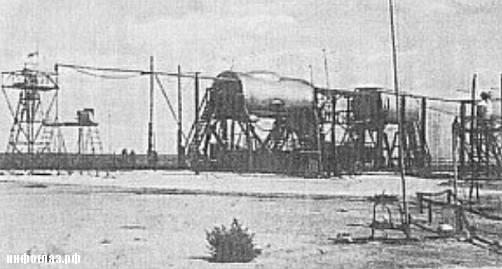
Placement of the reactor and radiation sensors on the Tu-95LAL
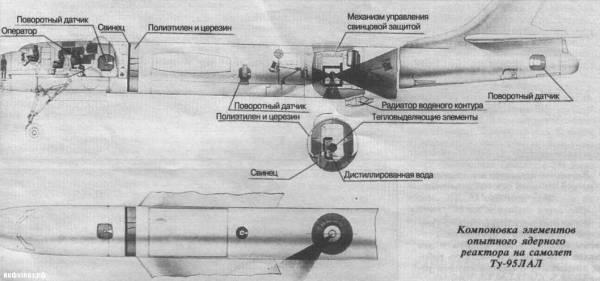
During these meetings were formulated and the main goal of LAL, including study the effect of radiation on the units and aircraft systems, checking the efficiency of a compact protection from radiation, experimental study of the reflection of gamma and neutron radiation from the air at different altitudes, the development of the operation of nuclear power plants. Compact protection has become one of the "know-how" Tupolev. In contrast to the OKB-23 projects, which provide space crew capsule with a spherical protection constant thickness in all directions, the designers of OKB-156 decided to apply the protection of variable thickness. The maximum level of protection provided for only on the direct radiation of the reactor, ie behind the pilots. At the same time, side and front cabin shielding should be minimized due to the need to absorb light reflected from the surrounding air. For an accurate assessment of the level of the reflected radiation, basically, and put the flight experiment.
For the preliminary study and gain experience with the reactor provided for the construction of ground test stand design works which were entrusted Tomilinskaya branch bureau, headed I.F.Nezvalem. Stand created based on the middle part of the fuselage of the Tu-95, with a reactor installed on a special platform to the lift and if necessary, it could be omitted. Radiation protection at the stand, and then at LAL, was produced using a completely new aviation materials for the production of which required new technologies.

Tu-95LAL.
--img18--









